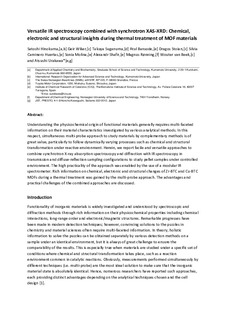| dc.contributor.author | Hinokuma, Satoshi | |
| dc.contributor.author | Wiker, Geir | |
| dc.contributor.author | Suganuma, Takuya | |
| dc.contributor.author | Bansode, Atul | |
| dc.contributor.author | Stoian, Dragos | |
| dc.contributor.author | Huertas, Silvia Caminero | |
| dc.contributor.author | Molina, Sonia | |
| dc.contributor.author | Shafir, Alexandr | |
| dc.contributor.author | Rønning, Magnus | |
| dc.contributor.author | Van Beek, Wouter | |
| dc.contributor.author | Urakawa, Atsushi | |
| dc.date.accessioned | 2019-03-21T14:10:10Z | |
| dc.date.available | 2019-03-21T14:10:10Z | |
| dc.date.created | 2018-05-04T13:03:35Z | |
| dc.date.issued | 2018 | |
| dc.identifier.citation | European Journal of Inorganic Chemistry. 2018, 2018 (17), 1847-1853. | nb_NO |
| dc.identifier.issn | 1434-1948 | |
| dc.identifier.uri | http://hdl.handle.net/11250/2591121 | |
| dc.description.abstract | Understanding the physicochemical origin of functional materials generally requires multifaceted information on their material characteristics, which are investigated by various analytical methods. In this respect, a simultaneous multiprobe approach to studying materials by complementary methods is of great value, particularly following dynamically varying processes, such as chemical and structural transformations under reactive environments. Herein, we report facile and versatile approaches to combining synchrotron X‐ray absorption spectroscopy and X‐ray diffraction with IR spectroscopy, in transmission and diffuse‐reflection sampling configurations, to study pellet samples under controlled environments. The high practicality of the approach is enabled by the use of a modular IR spectrometer. Rich information on the chemical, electronic, and structural changes of Zr–BTC and Cu–BTC MOFs during thermal treatment has been gained by the multiprobe approach. The advantages and practical challenges of the combined approaches are discussed. | nb_NO |
| dc.language.iso | eng | nb_NO |
| dc.publisher | Wiley | nb_NO |
| dc.title | Versatile IR spectroscopy combined with synchrotron XAS–XRD: Chemical, electronic, and structural insights during thermal treatment of MOF materials | nb_NO |
| dc.type | Journal article | nb_NO |
| dc.type | Peer reviewed | nb_NO |
| dc.description.version | acceptedVersion | nb_NO |
| dc.source.pagenumber | 1847-1853 | nb_NO |
| dc.source.volume | 2018 | nb_NO |
| dc.source.journal | European Journal of Inorganic Chemistry | nb_NO |
| dc.source.issue | 17 | nb_NO |
| dc.identifier.doi | 10.1002/ejic.201800140 | |
| dc.identifier.cristin | 1583494 | |
| dc.description.localcode | This is the peer reviewed version of an article, which has been published in final form at https://doi.org/10.1002/ejic.201800140. This article may be used for non-commercial purposes in accordance with Wiley Terms and Conditions for Self-Archiving. | nb_NO |
| cristin.unitcode | 194,66,30,0 | |
| cristin.unitname | Institutt for kjemisk prosessteknologi | |
| cristin.ispublished | true | |
| cristin.fulltext | postprint | |
| cristin.qualitycode | 1 | |
